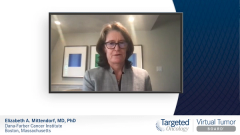
Germline BRCA1/2 Mutations in Metastatic TNBC
Dr Hope Rugo discusses the importance of testing for germline BRCA1/2 mutations in patients with triple-negative breast cancer.
Episodes in this series

Hope Rugo, MD: When you choose the chemotherapy regimen, you really have to understand how the patient has responded in the neoadjuvant and adjuvant settings. In the patient we have today, she relapsed quite a long time after her most recent taxane therapy, which was given in the neoadjuvant setting. Nab-paclitaxel is an excellent chemotherapy choice in that situation. For patients who have relapsed at 6 months from their taxane exposure, gemcitabine and carboplatin would be our chemotherapy choice. Because of the data from IMpassion131 that we just discussed, a patient who is going to receive a taxane should probably receive nab-paclitaxel. Our best data are with nab-paclitaxel, so I don’t see any reason why you would select paclitaxel as a chemotherapy partner for a checkpoint inhibitor.
What if our patient had the same situation, but her tumor tested positive for a germline mutation in BRCA1? Would we change our approach? We’ve talked about this a lot. The 1 thing that would change based on data presented at the 2021 ASCO [American Society of Clinical Oncology] Annual Meeting is that this patient would have received the PARP inhibitor, olaparib, as her adjuvant therapy. The question about what we do with capecitabine remains to be answered, but the data from the OlympiA trial showed a remarkable improvement in invasive disease-free survival and a distant disease-free survival, although that number included new primary tumors, which we know to be higher in patients with BRCA mutations. There’s even a numeric difference that’s not statistically significant in overall survival, so these data are practice-changing.
If she presents with metastatic disease but hasn’t seen a PARP inhibitor, we know she has disease that was sensitive to carboplatin in the neoadjuvant setting even without a pCR [pathologic complete response]. We would take the exact same approach that I’ve defined here for the patient who didn’t have a BRCA1 mutation. The reason is because we’ve seen such a remarkable survival benefit in IMpassion130. Even though this was complicated statistically, it’s still a big numeric survival difference. We’d still use the same nab-paclitaxel, atezolizumab approach.
When would we use the PARP inhibitor? We generally give a PARP inhibitor in the second-line setting, but a fascinating idea that’s now being studied in the KEYLYNK-009 trial with pembrolizumab is the concept that you could use a checkpoint inhibitor in the maintenance phase combined with a PARP inhibitor. We know that PARP inhibitors can potentially enhance the immune activation of the tumor via the cGAS–STING [stimulator of interferon genes] pathway and interferon. For this reason, there are ongoing studies looking at combinations of checkpoint inhibitors and PARP inhibitors in metastatic disease. What better way to try to improve the duration of disease control than to take patients who’ve had a good response to, for example, chemotherapy and a checkpoint inhibitor, continue the checkpoint inhibitor, discontinue the chemotherapy, and add the PARP inhibitor, which we know to be safe. We don’t have any data to encourage this as standard clinical practice at this time, but it’s an intriguing question. And certainly, maintenance PARP inhibition has been very successful in ovarian cancer.
Right now, that would only be a question in patients who have germline BRCA mutations: BRCA1 or BRCA2. The KEYLYNK-009 trial is studying this in all-comers in looking at HRD [homologous recombination repair deficiency] as well as germline mutations.
Transcript edited for clarity.














































